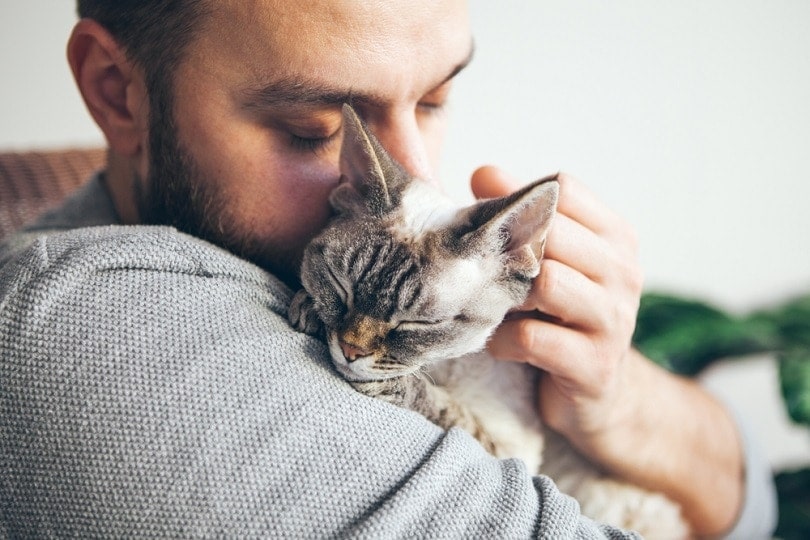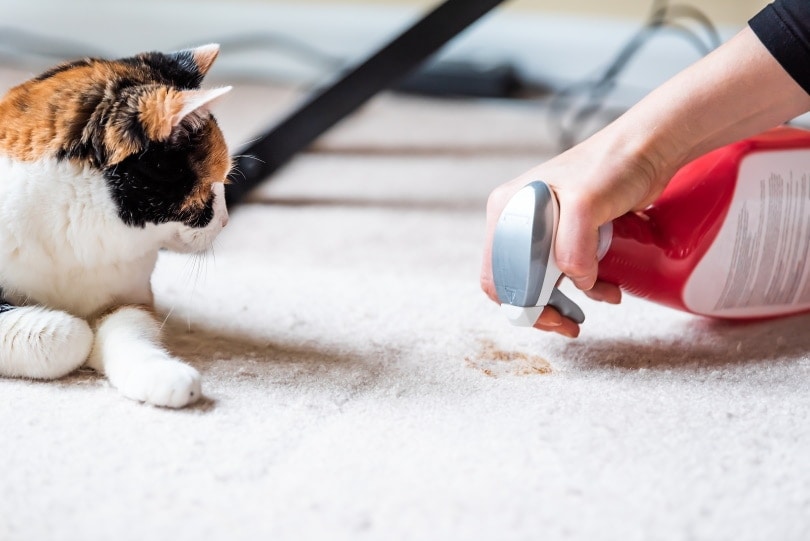How to Keep a Cat from Using a Dog Door: 5 Expert Tips

Updated on
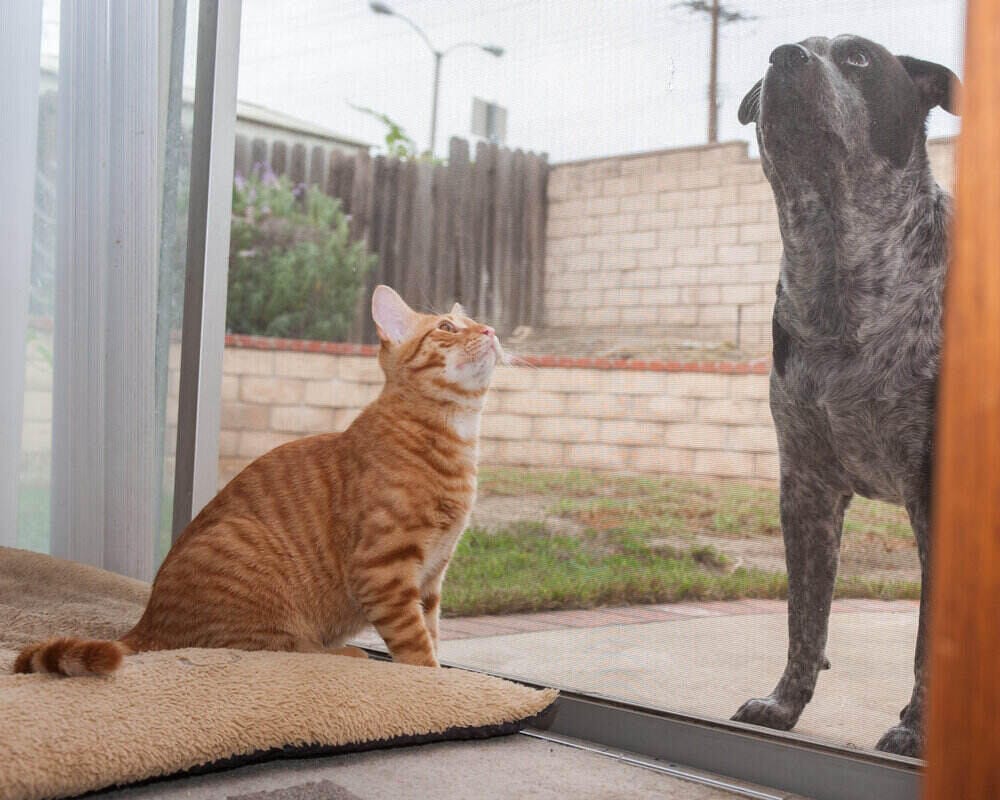
Is your cat sneaking through the dog door and going outside when they’re supposed to stay indoors? Well, you’re not alone. Many pet owners struggle with keeping their feline friends from accessing areas they shouldn’t. In this article, we’ll take a look at some of the best ways to keep your cat from using the dog door. These tips and insights will provide you with the tools you need to keep your cat safely indoors. Let’s discuss.
Why Is Your Cat Using the Dog Door?
Cats are naturally independent creatures. They love to explore their surroundings and have a strong desire for freedom. So, it’s no wonder that your cat might be tempted to use the dog door to venture outside. However, there could be several reasons why your cat is using the dog door, and it’s important to understand these reasons before addressing the issue.
One possible reason is that your cat may be feeling anxious or stressed indoors. Cats are known to be sensitive animals, and any changes in their environment or routine can cause them to feel uneasy. If your cat is experiencing any anxiety, they may seek solace by escaping through the dog door. Another reason could be that your cat is simply bored. Cats are super active animals, and if they don’t have enough mental and physical stimulation indoors, they may resort to using the dog door as a means of entertainment.
Also, it’s possible that your cat is using the dog door because they have associated it with something positive. So, for example, if they have found food or treats outside, they may continue to use the dog door in search of more rewards. Understanding the underlying reasons behind your cat’s behavior will help you address the issue more effectively. Here are some tips to keep a cat from using the dog door.
The 5 Tips for How to Keep a Cat from Using a Dog Door
1. Train Your Cat to Use a Designated Cat Door
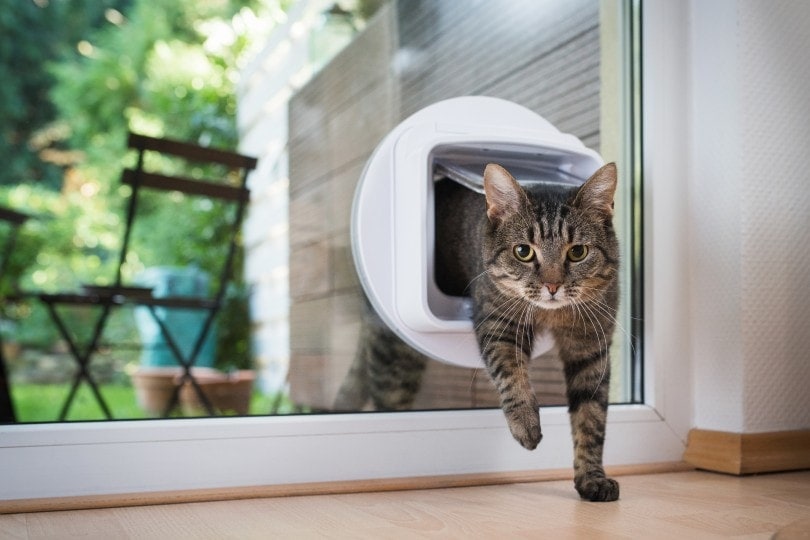
One effective way to prevent your cat from using the dog door is to simply train them to use a designated cat door instead. A cat door is specifically designed for cats, allowing them easy access to certain areas of the house, while keeping them away from areas they shouldn’t be in. Here’s how you can train your cat to use a cat door.
Make or Use a Cat-Specific Door
There are various cat-specific doors available in the market that are designed to allow only cats to pass through. Many of these doors like this usually have a locking mechanism that can be set to allow entry only for cats wearing a special collar or tag. This ensures that your cat can move freely while keeping other animals out.
Choose the Right Location
Select a suitable location for the cat door. Consider placing it in an area where your cat spends a lot of time or near their litter box or food and water bowls. This will make it easier for your cat to associate the cat door with positive experiences.
Introduce the Cat Door Gradually
It’s best to start things off slow. So, start by propping the cat door open and enticing your cat with treats or their favorite toys. Allow them to explore the cat door at their own pace. Once they’re comfortable with the open door, gradually lower it to a partially closed position. Doing it this way will help your cat get used to pushing the door open and entering through it.
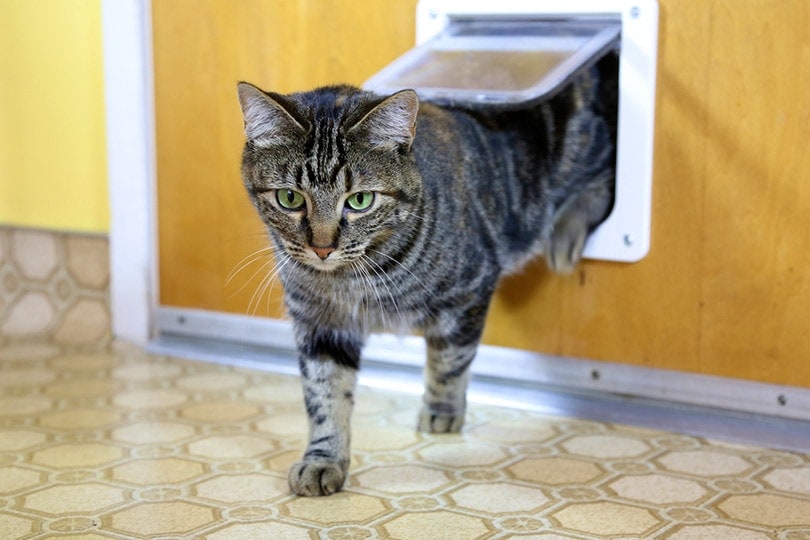
Use Positive Reinforcement
Whenever your cat successfully uses the cat door, reward them with praise, treats, or playtime. Positive reinforcement will strengthen the association between using the cat door and receiving rewards, making it more likely for your cat to continue using it.
Be Patient & Consistent
Training your cat to use a cat door may take time, so be patient and consistent with your efforts. Avoid forcing your cat through the door or scaring them in any way, as this can create negative associations and hinder their progress. With time and positive reinforcement, your cat will learn to use the cat door confidently.
By training your cat to use a designated cat door, you can provide them with a safe and accessible way to move around the house while keeping them away from the dog door.
2. Install a Cat-Specific Door or Modify the Existing Dog Door
If training your cat to use a cat door doesn’t seem feasible or if you don’t have a suitable location for one, you may want to consider modifying the existing dog door to make it less accessible to your cat.
Modifying the Dog Door
If you already have a dog door installed and want to make it less accessible to your cat, you can just modify it by adding a barrier or an extension. So, for example, you can attach a panel to the dog door that reduces the opening size, making it too small for your cat to squeeze through.
Alternatively, you can install a sensor that detects your cat’s presence and automatically locks the dog door when they approach or install a dog door that comes with a collar and only opens when your dog approaches wearing the collar. When modifying the dog door, it’s important to ensure that your dog can still comfortably use it. So be sure to consider the size and needs of both your dog and cat when making any modifications.
3. Create a Safe & Comfortable Indoor Environment
One of the reasons your cat may be using the dog door is because they’re seeking something that they feel is missing indoors. So, by creating a safe and comfortable indoor environment for your cat, you can minimize their desire to venture outside.
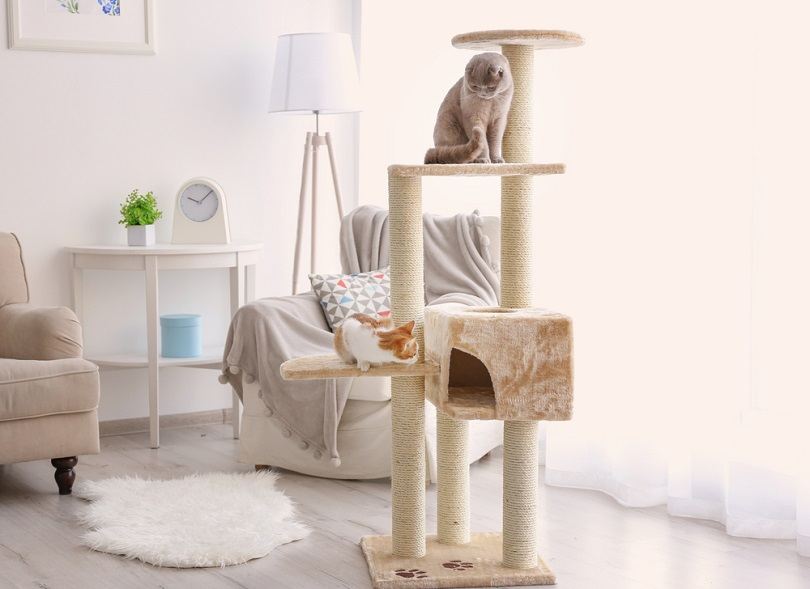
Provide Enrichment
Remember that cats need mental and physical stimulation to prevent boredom and satisfy their natural instincts. Make sure to provide plenty of toys, scratching posts, climbing trees/shelves, and interactive play sessions to keep your cat engaged and entertained. This will effectively reduce their need for outdoor exploration.
Give Them a Cozy Space
Create a designated space for your cat where they can relax and feel secure. Set up a comfortable bed or blanket, provide access to a window for birdwatching, and consider using pheromone diffusers or calming sprays to create a soothing environment. Cats love cozy spaces to retreat during downtime and at the end of the day–which explains why they may climb in bed with you at night.
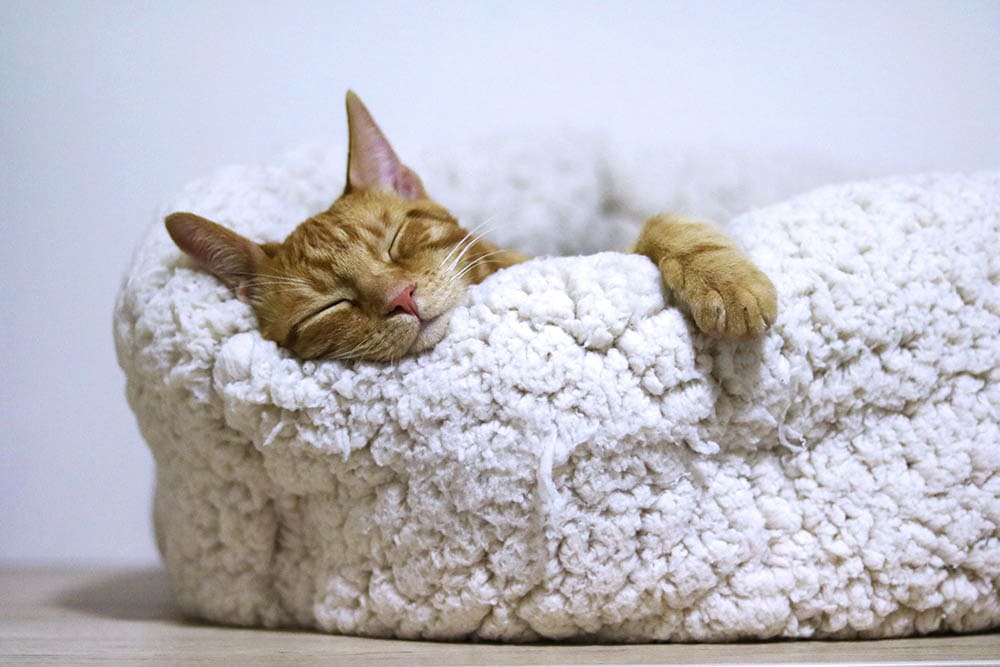
Get a Routine
Most domesticated mammals thrive on routine–this includes felines. Stick to a consistent feeding schedule, regular litter box maintenance, and regular playtime routine. This will provide structure and predictability for your cat, reducing their stress levels and minimizing the desire to escape through the dog door.
Make Sure They’ll Well Fed
Make sure your cat is receiving a balanced and nutritious diet–hungry cats may be tempted to roam outdoors. If needed, reach out to your vet to determine the appropriate type and amount of food for your cat’s age, size, and current state of health. A well-fed cat is way less likely to seek food sources outside.
4. Address Any Underlying Issues or Anxieties
If your cat continues to use the dog door despite your best efforts, it may be a sign of underlying issues or anxieties that need to be addressed. Cats can be sensitive to changes in their environment, and any disruptions can cause them stress or anxiety.
Environmental Changes
Cats are creatures of habit and can become stressed when their environment changes. Have there been any recent changes in your home, such as a new pet, a move, or renovations? These changes can disrupt your cat’s sense of security and trigger the desire to escape through the dog door.
Lack of Vertical Space
Cats love to climb and perch on high surfaces. If your home lacks vertical space or suitable perches, your cat may feel confined and seek an escape route through the dog door. Consider providing tall cat trees or shelves where your cat can climb and observe their surroundings. You can buy shelves on Amazon or Walmart and install them in your home or in the backyard. This can give your cat ways to burn off energy, get exercise, and relieve stress.
Litter Box Issues
Inappropriate elimination is a common sign of stress or anxiety in cats. And if your cat isn’t using the litter box consistently or is using the bathroom outside of it, they may be trying to communicate their discomfort. So, ensure that the litter box is clean, easily accessible, and located in a quiet area away from high traffic areas. Cats actually prefer privacy. And if you suspect that your cat’s behavior is driven by underlying issues or anxieties, you can even consult with a vet or a certified animal behaviorist, as they can help identify and address the root cause of your cat’s behavior.
5. Utilizing Deterrents & Reinforcements
In addition to training and creating a cat-friendly environment, you can utilize deterrents and reinforcements to discourage your cat from using the dog door. Let’s look at some strategies to consider:
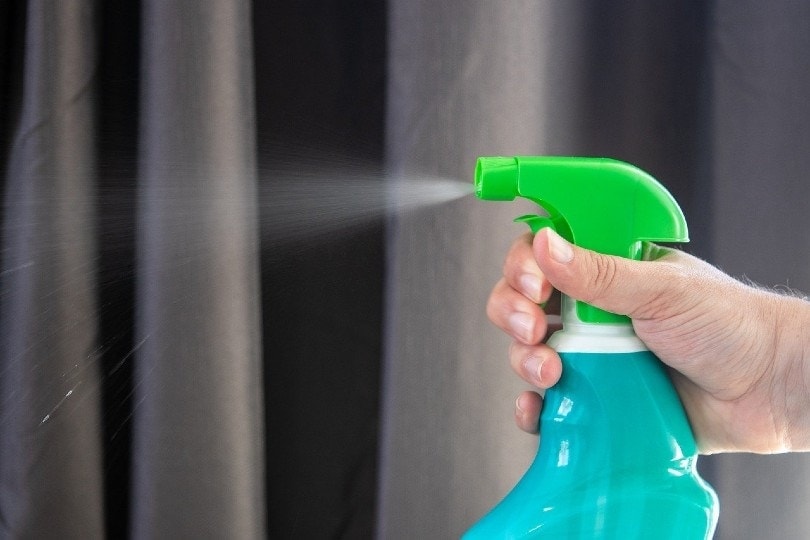
Deterrents
Consider placing deterrents like motion-activated devices near the dog door to make it less appealing to your cat. These devices typically emit a loud noise, lights, or bursts of air upon detecting your cat’s presence. You can also use natural deterrents like citrus-scented sprays or double-sided tape to discourage your cat from approaching the dog door.
Positive Reinforcements
Offer rewards and positive reinforcements for your cat when they choose to stay indoors or use the designated cat door. This can include treats, praise, or extra playtime. By associating positive experiences with staying indoors, you can encourage your cat to choose the desired behavior.
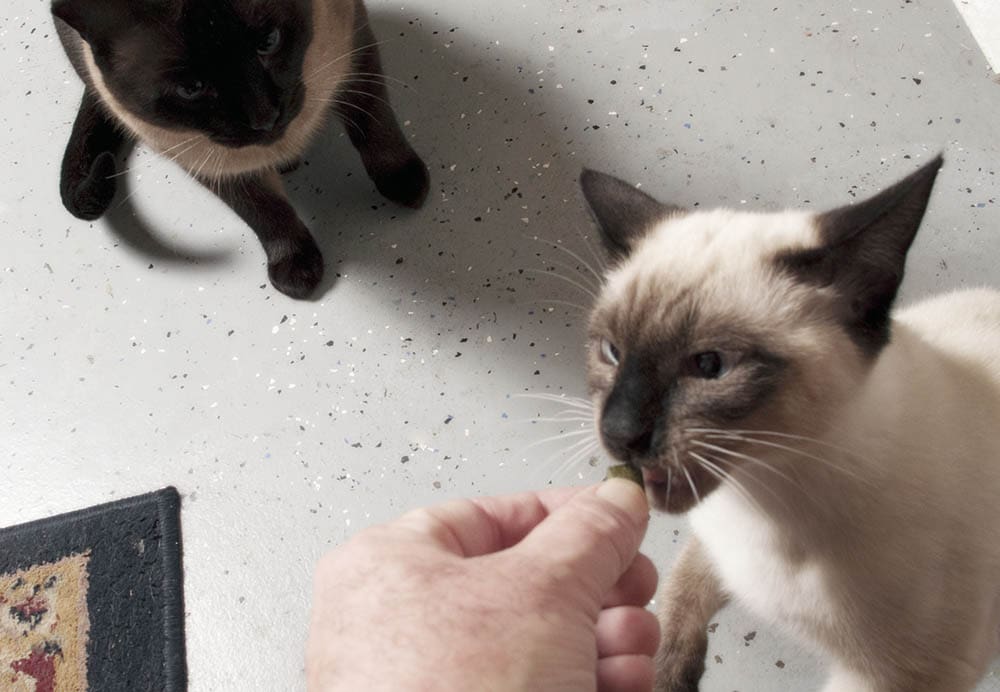
Visual Barriers
If your cat is tempted to use the dog door due to visual stimuli outside, consider using window coverings or blinds to block their view. Doing so may reduce their curiosity and minimize the desire to escape. Remember that you’ll need to be consistent with your deterrents and reinforcements to reinforce the desired behavior and discourage your cat from using the dog door.
FAQ About Cats & the Outdoors
Why does my cat keep running out the door?
There can be several possible reasons for this behavior. One reason could be that your cat is simply curious and wants to explore the outside world. Cats have an instinct to explore their surroundings, and when they see an opportunity to go outside, they may simply take it. Another reason could be that your cat is seeking attention or trying to escape from something inside the house, such as loud noises or other pets. Also, some cats may be motivated by the desire to hunt or chase after birds and other small animals they see outside. To prevent your cat from running out the door, it also helps to provide them with enough mental and physical stimulation indoors, like interactive toys and regular play sessions. You can also consider installing a screen door or using deterrent sprays near the exit to discourage your cat from attempting to escape.
Can my cat get sick from going outdoors?
Allowing your cat to roam outdoors can expose them to a variety of risks and potential illnesses. Outdoor cats are more likely to come into contact with infectious diseases, parasites, and other animals that may pose a threat to their health. Common illnesses that outdoor cats may contract include respiratory infections, feline leukemia, and feline immunodeficiency virus. Additionally, outdoor cats are at a higher risk of encountering accidents or injuries, such as bites from other animals or being hit by a vehicle. Does this mean that if you let your cat hang out in the backyard that it’s going to catch a disease? Not necessarily. But allowing them to roam the neighborhood or hang outdoors for extended periods of time can increase these chances.

Will letting my cat outdoors make it aggressive?
Allowing your cat to roam outdoors can potentially lead to an increase in aggression. When cats have access to the outdoors, they’re exposed to various stimuli such as other animals, unfamiliar people, and loud noises. These external factors can (in some cases, that is) trigger a stress response in cats, which may manifest as aggression–though this is less likely if you’re simply occasionally letting your cat out in a fenced backyard. Also, outdoor cats may become territorial and engage in fights with other animals, further fueling aggressive behavior. So, it’s essential to consider the potential risks and benefits before deciding whether to let your cat outdoors.
Wrapping Things Up
Keeping your cat from using the dog door may require some time and effort, but with these tips, you’re well-equipped to tackle the challenge. By implementing these strategies, you can enjoy a harmonious household where your cat stays safely indoors, and your dog can freely use the dog door without any unwelcome surprises. Remember to be patient and consistent and seek professional help if needed.
Featured Image Credit: Jon Osumi, Shutterstock


